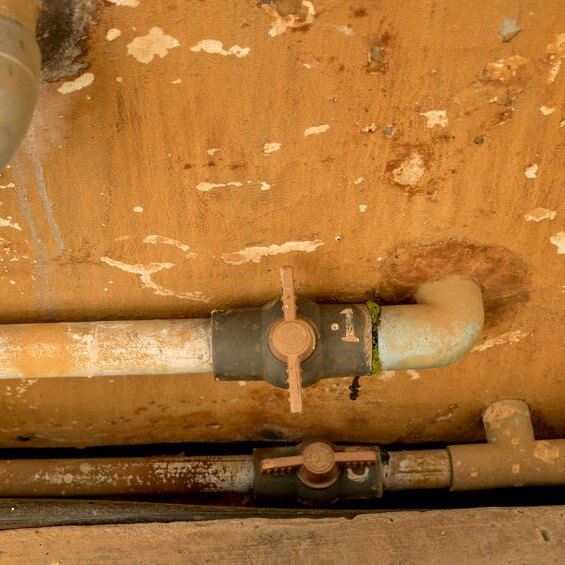Where is the water shut off valve?
Wherever there is plumbing, in a business, public building, or a home, there is a shut off valve. A water shutoff valve controls the flow of water to plumbing fixtures like the faucets, shower, toilet, tubs, washing machine, or any type of plumbing fixture.
A shut off valve will be found under the sink and the toilet tank, and for a bathtub or shower, it is inside an access panel located in the wall. A shut off valve has a handle and that is how you turn the water off and on to the connected inlet water pipe that is connected to the other end. A plumbing contractor may refer to this as either a shut off valve or ball valve, they are the same thing.
What are the different types of shut off valves?
As you own a home, you’ll experience many things with the electrical and the plumbing. When you come across an older water shut off valve, you will find there are several choices to choose a replacement.
There is an angled version and straight version of shut off valves. There is the multi-turn and quarter turn options in the valve with a variety of water supply line options to be considered. The following is a list of the most common shut off valves used in a home.
- Compression Fit Stop Valve: This shut off valve comes in multi-turn and quarter turn and is used with water supply lines made of copper or PEX.
- Sweat Fitting Stop Valves: This shut off valve is designed to connect to copper water line and be non-leak, non-removable.
- Push Fit Stop Valve: This shut off valve is a new technology that is easy to install and offers versatility.
- Female Iron Pipe Threaded Fitting Shutoff Valve: FIP, short for female iron pipe is a shut off valve that is used with galvanized water lines that are threaded and requires pipe thread compound, then screws on and off.
- Barbed Fitting Stop Valve: This shut off valve is used with PEX water lines and can be used with a compression fitting.
Can a shut off valve fail?
Shut off valves are a low maintenance part of plumbing in a home, but like anything, they get old and worn. The failure that is most common older shut off valves is they seize up and can’t be moved. When this happens, they cannot be turned by hand, which jeopardizes the purpose of shut off valves.
Another failure that is common with shut off valves is the rubber stop or seal that is located within the valve have deteriorated. If a shut off valve is leaking, this is usually the cause.
How do you fix a shut off valve?
If you have a leaking water shut off valve or your water shut off valve is stripped, the following are steps to take to repair the faulty shut off valve:
- Turn the water off to the house at the meter.
- With a screwdriver, pull the shut off valve handle off.
- Using a wrench, loosen the gland nut located on the back side of the handle.
- Unscrew the handle and remove the valve part of the shut off valve.
- Take the new valve from the repair kit and screw it in place.
- With the wrench, tighten the gland nut back, careful not to overtighten.
- Using the screwdriver, put the shut off valve handle back on.
- Turn the water back on at the meter.
Are water shut off valves required?
Currently, there isn’t any federal law stating water shut off valves are required. You should check local zoning laws and building ordinance. Depending on where you live and what type of structure you live, a shut off valve may be required at every water operating appliance. This would mean a water shut off is at every shower, sink, toilet, tub, dishwasher, washing machine, etc. It may be required to have both cold and hot water shut off valve.

Is it possible to repair a shut off valve without shutting off water?
The shut-off valves in houses are referred to as gate valves, a simple mechanism. There is a handle or wheel that causes a gate to lower or raise according to the water flow. An inexpensive and reliable component, until they fail.
However, the joint in the middle of the valve body and the valve stem are vulnerable in gate valves because of the rotating stem and valve body allow water to escape around the stem. Manufacturers of shut off valves created a solution that placed a waterproof barrier between the two parts referenced as a packing gland. It is typically made of grease fibers, leather, rubber, or some other material.
Over time, that material breaks down or hardens, and sometimes too high of water pressure will push it out of place. Either of these will allow the shut off valve to start leaking. To fix the shut off valve without shutting off the water, follow these steps:
- Dry the area around and the valve.
- Close the valve shut and take off the valve handle.
- Remove the packing gland’s follower.
- Wrap the packing gland and stem with plumber’s tape.
- Replace the gland follower and stem handle.
- Test the shut off valve.
If you move into a home that doesn’t have a water shut off valve at each water operated fixture, take the time and expense to install one yourself or have a plumber do the work. Either way, should you ever experience a water emergency, and you will, that water shut off valve will be your best friend and saving grace. Call (817) 476-9963 today for shut off valve repair in Fort Worth, TX.
